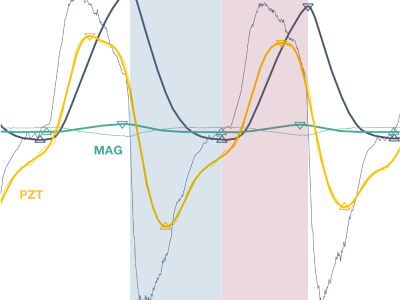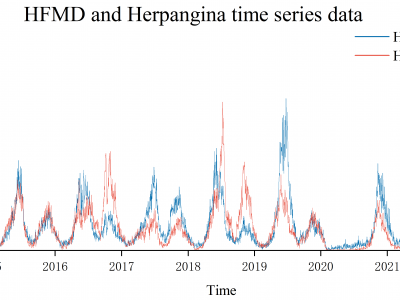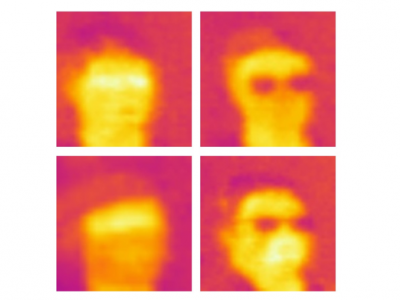Artificial Intelligence
This dataset is associated with TODOS: Thermal sensOr Data-driven Occupancy Estimation System for Smart Buildings. It is a novel system for estimating occupancy in intelligent buildings, TODOS uses a low-cost, low-power thermal sensor array along with a passive infrared sensor. We introduce a novel data processing pipeline that allows us to automatically extract features from the thermal images using an artificial neural network. Through an extensive experimental evaluation, we show that TODOS provides occupancy detection accuracy of 98% to 100% under different scenarios.
- Categories:
 1154 Views
1154 ViewsDataset for validation of a new magnetic field-based wearable breathing sensor (MAG), which uses the movement of the chest wall as a surrogate measure of respiratory activity. Based on the principle of variation in magnetic field strength with the distance from the source, this system explores Hall effect sensing, paired with a permanent magnet, embedded in a chest strap.
- Categories:
 496 Views
496 ViewsDataset for validation of a new magnetic field-based wearable breathing sensor (MAG), which uses the movement of the chest wall as a surrogate measure of respiratory activity. Based on the principle of variation in magnetic field strength with the distance from the source, this system explores Hall effect sensing, paired with a permanent magnet, embedded in a chest strap.
- Categories:
 67 Views
67 ViewsThe daily case data for HFMD (Hand-Foot-and-Mouth Disease) and herpangina were collected from the Children’s Hospital of Chongqing Medical University, a national clinical medical research center of China, spanning from January 1, 2015, to December 31, 2021. This dataset contains the timestamp of each patient's discharge, resulting in a total of 109,096 records for HFMD and 133,869 records for herpangina.
- Categories:
 201 Views
201 Views
This dataset, presents the results of motion detection experiments conducted on five distinct datasets sourced from changedetection.net: bungalows, boats, highway, fall and pedestrians. The motion detection process was executed using two distinct algorithms: the original ViBe algorithm proposed by Barnich et al. (G-ViBe) and the CCTV-optimized ViBe algorithm known as α-ViBe.
- Categories:
 223 Views
223 Views
This dataset, presents the results of motion detection experiments conducted on five distinct datasets sourced from changedetection.net: bungalows, boats, highway, fall and pedestrians. The motion detection process was executed using two distinct algorithms: the original ViBe algorithm proposed by Barnich et al. (G-ViBe) and the CCTV-optimized ViBe algorithm known as α-ViBe.
- Categories:
 153 Views
153 Views
Multimodal reasoning is a critical component in the pursuit of artificial intelligence systems that exhibit human-like intelligence, especially when tackling complex tasks. While the chain-of-thought (CoT) technique has gained considerable attention, the existing ScienceQA dataset, which focuses on multimodal scientific questions and explanations from elementary and high school textbooks, lacks a comprehensive evaluation of diverse approaches.
- Categories:
 24 Views
24 Views
Most existing video text spotting benchmarks focus on evaluating a single language and scenario with limited data.
In this work, we introduce a large-scale, Bilingual, Open World Video text benchmark dataset (BOVText V2). There are four
features for BOVText V2. Firstly, we provide 2,000+ videos with more than 1,750,000+ frames, 25 times larger than the existing
- Categories:
 41 Views
41 ViewsWe extend the existing thermal infrared face dataset (TIF) by improving the diversity and quality of data. More specifically, the new data contains more acquisition periods with significant differences among ambient temperature periods and a slow change in ambient temperature within each period. At the same time, we provide the corresponding visible images of the infrared images to assist in face detection and face depth estimation. For noise reduction, we calculated the average facial temperature of the short-term population and determined upper and lower limits.
- Categories:
 297 Views
297 ViewsMapping millions of buried landmines rapidly and removing them cost-effectively is supremely important to avoid their potential risks and ease this labour-intensive task. Deploying uninhabited vehicles equipped with multiple remote sensing modalities seems to be an ideal option for performing this task in a non-invasive fashion. This report provides researchers with vision-based remote sensing imagery datasets obtained from a real landmine field in Croatia that incorporated an autonomous uninhabited aerial vehicle (UAV), the so-called LMUAV.
- Categories:
 1156 Views
1156 Views




